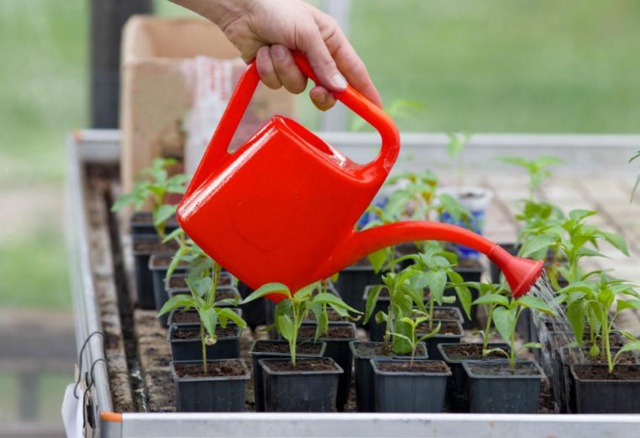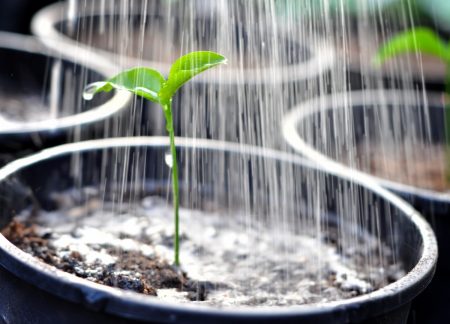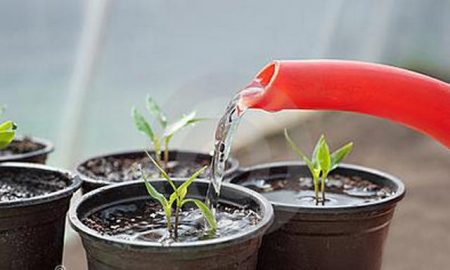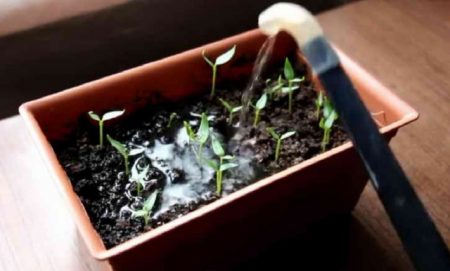 Proper care of seedlings is the key to obtaining strong and healthy plants that will bear fruit well. Water pepper, which is already complicated, many will think. Excessive and inadequate irrigation can be detrimental to pepper.
Proper care of seedlings is the key to obtaining strong and healthy plants that will bear fruit well. Water pepper, which is already complicated, many will think. Excessive and inadequate irrigation can be detrimental to pepper.
Content
General rules for watering seedlings
For a long time, farmers watched the pepper in order to develop general rules for watering. Water allows you to dissolve numerous nutrients and deliver them to the cells and tissues of the plant. Therefore, you need to understand how much water the pepper needs in order for it to develop normally.
Proper humidity
The microclimate for each plant is purely individual. Pepper is a thermophilic plant. Consider what should be the level of humidity for him.
- After a pick, during the growth period, pepper likes high humidity. It should be at around 60-65%. Do not forget about maintaining the air temperature at +25 degrees. Only in symbiosis, these two factors will positively affect the development of seedlings. Separately, they will destroy the plants.
- Soil moisture during the development of seedlings should be in the range of 75-80%. Watering the soil to carry out warm water 20-30 degrees.

To control air humidity, you will need to buy an inexpensive thermometer that measures humidity. For a home greenhouse, an ordinary inexpensive device is suitable, in large farmers they use special sensors that determine the correct humidity level with high accuracy.
Frequency and usefulness of irrigation
The frequency of watering for pepper after a dive is 2-3 times a week.
- Keep track of the soil and water the plants as they dry.
- Pour pepper is not worth it. Water should not stand in pots after watering, pay attention to this.
- If you carry out liquid top dressing, then you do not need to additionally water pepper.
After a dive, the pepper is slightly weakened. Watering for him can be not just a process of saturation with moisture, but also the introduction of nutrients.
- The first dressing can be done a few days after transplanting pepper into separate pots. To prepare the solution you need: 0.5 teaspoon of urea, 2.5 ml. potassium humate and 2 liters. water. Watering is not plentiful.
- The second feeding is done after 14-15 days after the first. It is carried out by a solution with ammonium nitrate (2 g), superphosphate (9 g), potassium (3 g). Water will need 2 liters. for so many fertilizers.

The usefulness of top dressing during this period is:
- increasing pepper resistance to disease;
- the formation of a strong root system;
- the development of green mass.
Variety of water and effect on seedlings
- Rainwater was previously considered the best for watering seedlings. It is soft in composition and contains a high percentage of dissolved oxygen. Now the ecology is very poor, so watering the seedlings with rain water can destroy it.
- Doubtful for watering seedlings is river and lake water. Today, many different chemicals and wastes flow into the rivers, which they certainly cannot positively influence the plants.

- Tap water contains many cleaning additives that can negatively affect the plant, so it must be defended.
- Water from a well and wells is the most suitable option for watering seedlings.But, it is worth considering that sources saturated with a high concentration of mineral salts are not suitable for watering seedlings.
You can purify water from impurities, but this is a costly affair. Therefore, use well-maintained tap water and well water.
Reviews:
Alexandra Artemovna:
After diving, pepper was not often watered. When the land began to dry out, so I watered the seedlings, about twice a week. She made a pick in peat pots, which she then planted with pepper. She irrigated the land with settled tap water, which she heated before watering.

Nikolai Fedorovich:
I live in a village, we don’t have a water supply, so I watered pepper seedlings from a well. He made a pick when the plant threw a couple of leaves. I watered twice with fertilizer water. In the planted cassettes pepper looked "solid." On the open ground he began quickly, the root system was strong.




 Calorie pepper stuffed with meat and rice - BZHU per 100 grams
Calorie pepper stuffed with meat and rice - BZHU per 100 grams Gorky pepper - the best varieties for open ground
Gorky pepper - the best varieties for open ground Hot pepper seeds - the best varieties for open ground and reviews
Hot pepper seeds - the best varieties for open ground and reviews Capsicum tincture for hair - how to use and reviews
Capsicum tincture for hair - how to use and reviews